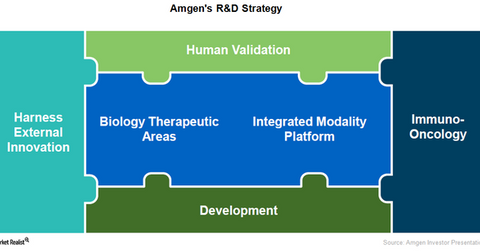Amgen’s Research and Development Strategy
Amgen (AMGN) has adopted a well-structured research and development strategy focused on inflammation, metabolism, bone, and cardiovascular diseases.
Sept. 11 2015, Updated 11:06 a.m. ET

Research and development strategy
Amgen (AMGN) has adopted a well-structured research and development strategy focused on unmet needs in target areas such as inflammation, oncology, and neuroscience, as well as metabolism, bone, and cardiovascular diseases.
In the first half of 2015, research and development expenses as a percentage of total revenues for Amgen, Celgene (CELG), Biogen (BIIB), and Gilead Sciences (GILD) amounted to 17.8%, 37%, 18.5%, and 8.7%, respectively. With substantial investment at stake, Amgen has designed its overall research and development strategy in a way that ensures operational efficiencies and generates healthy return on investment.
Research and development strategy
Amgen combines the use of various complementary technologies with a special focus on biologics to develop innovative drugs. In addition, the company aims to combine internal development skills with expertise obtained from collaborations and mergers. The company has also increased its focus on validating target drugs to ensure that they have the required efficacy and safety profiles. These trials also help Amgen demonstrate these drugs’ value to various regulatory bodies, which is required for launching drugs in new markets.
Discovery research
Amgen has increased its focus on developing new drugs in the immuno-oncology segment. The company has received approval from the Food and Drug Administration, or FDA, for its oncology drug Blincyto, based on the new BiTE platform. This technology is expected to prove superior to existing drugs and subsequently form the base of the majority of future oncology drugs.
Amgen’s strategy to consolidate various technologies in one integrated platform has also helped it realize scientific synergies. Amgen has also tested PCSK9, sclerostin, and calcitonin gene-related peptide, or CGRP, which have further confirmed the superior clinical profile of these drugs.
Investors can get diversified exposure to Amgen’s strong research and development strategy, yet avoid unique company risks, by investing in the iShares NASDAQ Biotechnology ETF (IBB). IBB has 8.53% of its total holdings in Amgen.
